How to choose the right membership management software
Managing community memberships with a manual system like spreadsheets, Paypal links, and scattered lists is an extreme sport.
It may work, but chances are, overwhelm and burnout would be the order of the day.
The truth is that scaling without systems can very quickly become an Achilles heel for your business—and turn you into a “how startups fail” statistic.
That’s why so many successful creators—like Jay Clouse, Kristen Bousquet, and Pat Flynn—trust in membership management tools like Circle to help scale their businesses while keeping high quality member experiences.
Want the same for your community? Your first step is picking the right tool—and that starts with knowing what features matter most. But before we get into that, let’s cover the basics.
What is membership management software?
Membership management software helps you manage everything your community needs, from tracking data and processing payments to organizing events and communicating directly with members. So instead of bouncing between apps or cobbling together a solution, it acts as your all-in-one headquarters.
Say you manage a professional association, run a fitness club, sell a course, or host an online community. The right platform lets you focus less on logistics and more on what truly matters—creating meaningful experiences for your members. (And of course, ensuring your membership provides you some income–if that’s the way your business is structured.)
What’s the difference between membership management software and a CRM?
Both membership management software and CRM (customer relationship management) systems streamline your interactions with people. The big difference is in who they’re built for.
- Membership management software tools are purpose-built for communities and handle tasks like tracking memberships, managing renewals, automating operations, organizing events, and fostering engagement. They’re for creators, businesses, and organizations that want to create and grow an engaged community.
- CRM tools manage sales and customer relationships. They help businesses manage leads, track deals, and analyze customer interactions. That’s why CRM platforms like HubSpot, Salesforce, and Zoho CRM are better for businesses focused on customer acquisition and lifecycle management rather than community engagement.
👉🏽 CRM is about nurturing prospects and closing deals, while membership management software is about growing relationships, retaining members, and building a thriving community.
8 critical features to look for in a membership management tool
Ready to choose a membership platform for your community? Look out for these 8 must-have features.
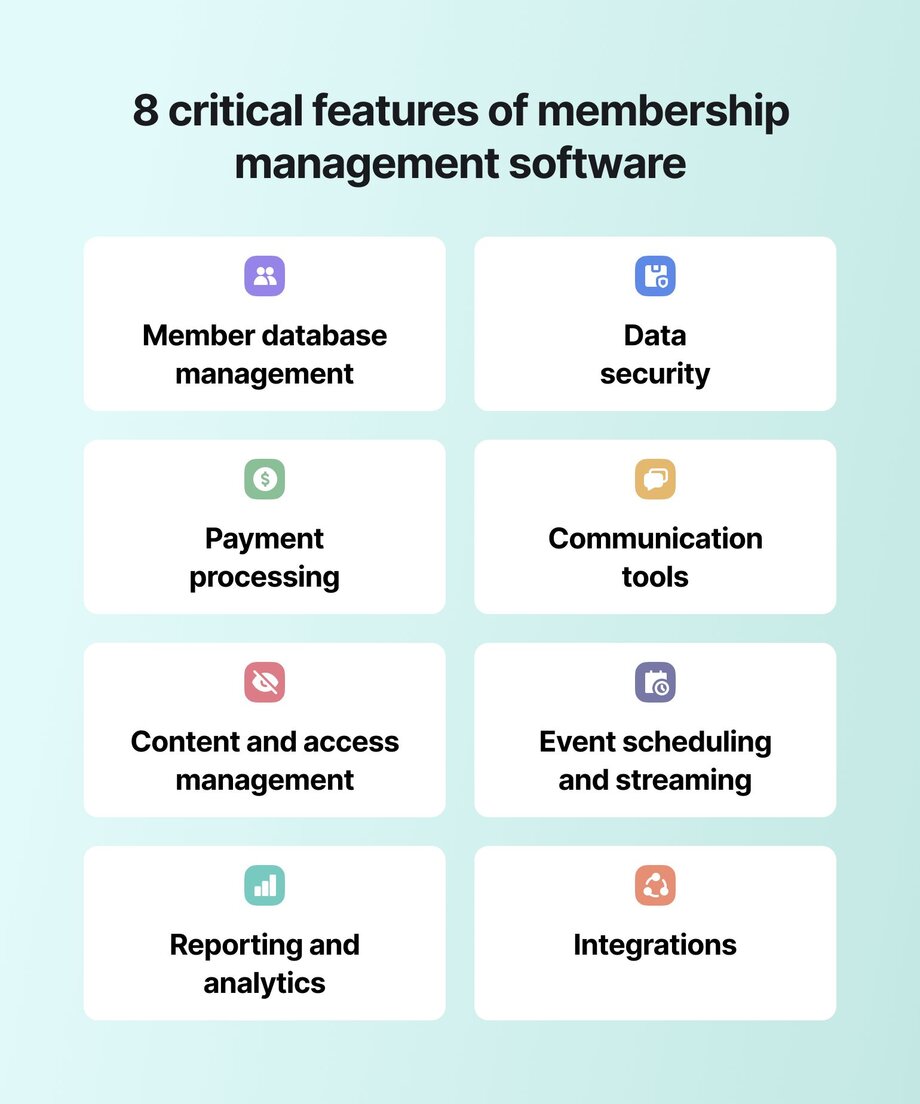
1. Member database and profile management
A well-organized online membership system makes it easy to filter and find whatever information you need. Look for a tool that simplifies data organization and searchability with customizable member profiles.
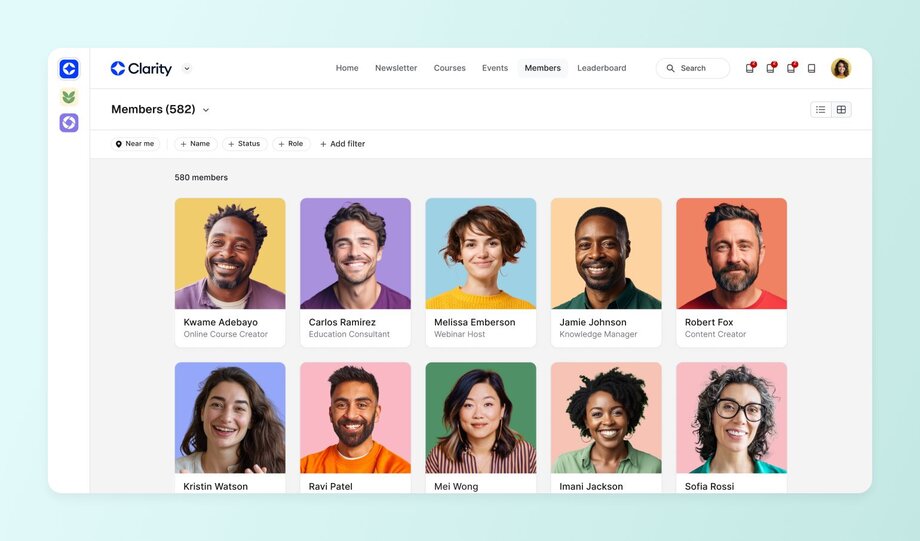
For example, Circle’s member directory and audience management features let you view individual user profiles, coordinate local groups, start masterminds, find your most active members, and regulate community activities seamlessly.
2. Data security
Considering the increase in cyber breaches and incidents, the membership software should also have robust privacy and security features, like data encryption, to protect sensitive materials.
With Circle, for instance, our Data Processing Addendum (DPA) shows how we process and store user data.
💡 Hint: Circle’s DPA aligns with all applicable data protection laws, from the GDPR to Swiss Data Protection Laws, and the US Data Protection Laws.
3. Payment processing and billing
Payment processing and billing are key to community monetization. But, they can be big headaches when done manually or on separate apps.
Get paid faster and easier with membership management software that offers recurring payment handling and automated invoicing and receipts. These features will give you full control of how you gate and charge for community access, whether that’s through one-time coaching sessions, annual subscriptions, or installments.
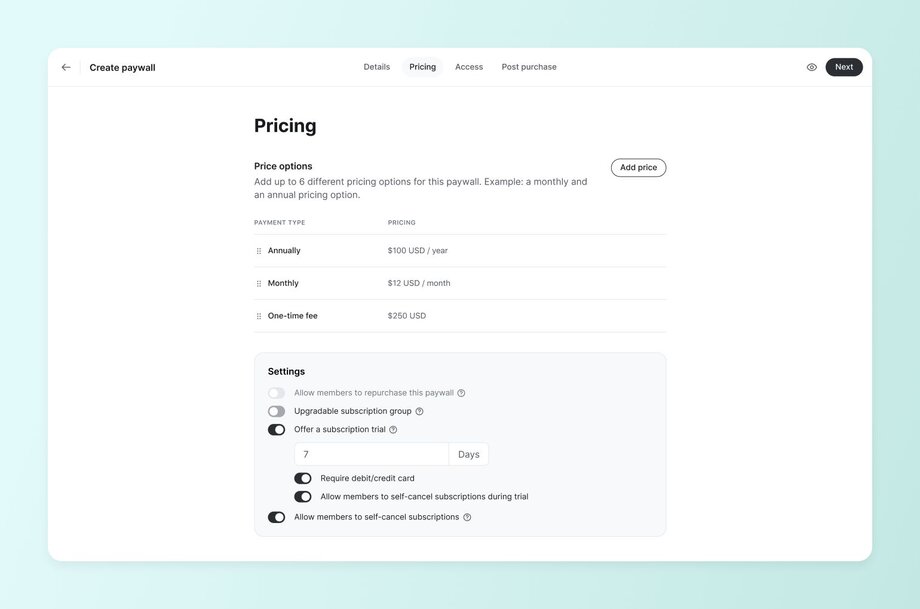
A tool like Circle, with multiple paywall options, can improve ease of use and ensure members can pay from anywhere, at any time.
4. Communication tools
Conversations are the heartbeat of every community, and discussion boards, chats, and organized chat spaces keep them going.
Communication tools are especially important if you’re cultivating a member-led community. It’s easier to engage your members and drive meaningful discussions with a membership management system that offers:
- Email automation and announcement features to support direct-to-inbox broadcasts, marketing automation building, and audience management.
💡Hint: Circle even automatically pulls together a weekly community digest for the most recent posts in your community!

- Membership messaging systems to help you and your members interact via DMs, group chat spaces, and discussion boards.
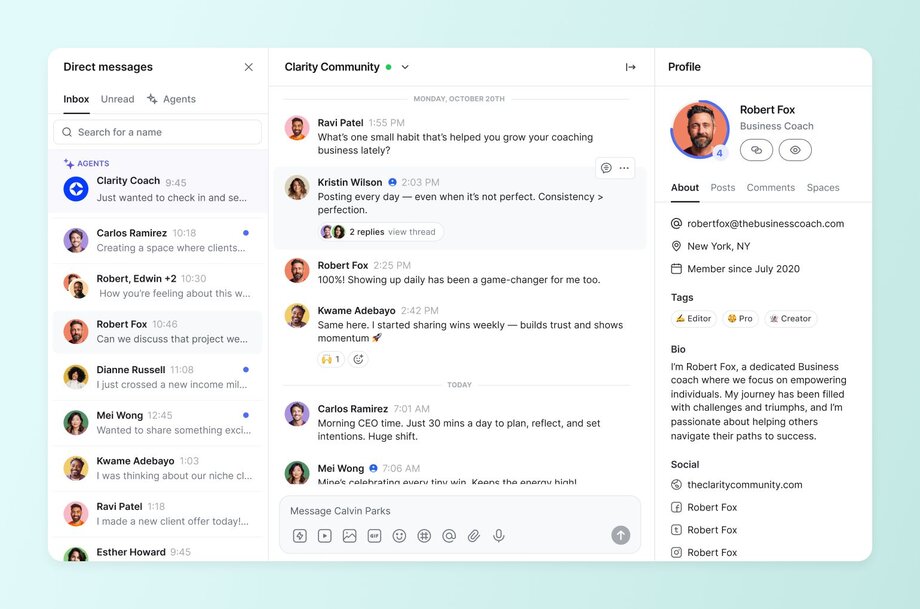
- Integrations with marketing tools—like Airtable, Google Analytics, WordPress, and Facebook—so you can automate promotional activities, seamlessly fill your funnel, and make time for other crucial community tasks.
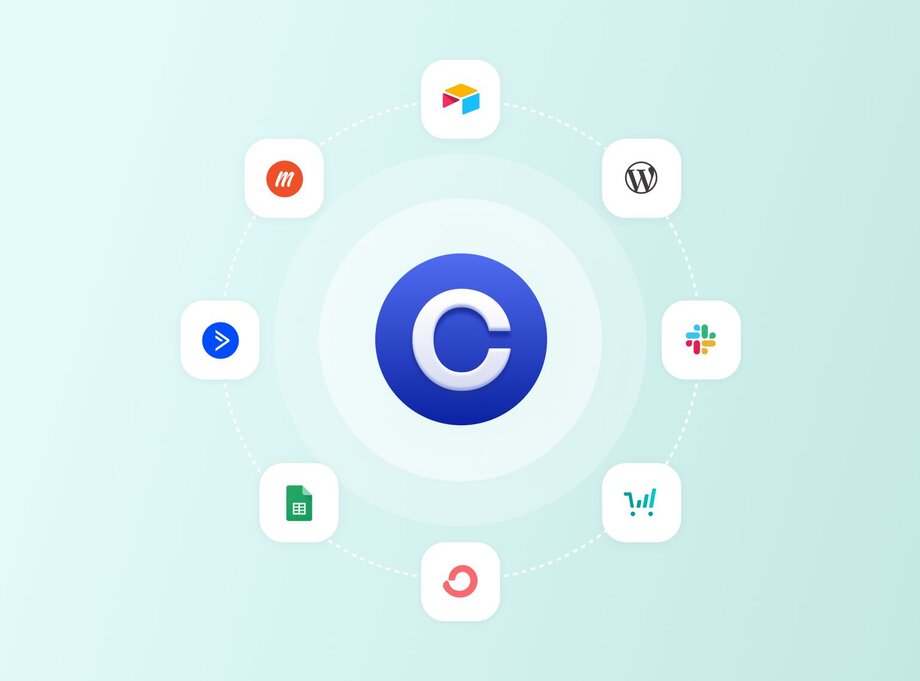
- AI capabilities, including intelligent agent building, idea generation, writing, editing, automated transcriptions, and content repurposing, can speed up your community admin without losing your authenticity.

💡 Pro tip: To boost engagement between members, combine communication with gamification triggers. For example, you can highlight active members and popular posts in your community digest, or use AI to reach out to active posters to reward them.
5. Access control and content management
Want to create free or paid content libraries without worrying about unauthorized access?
Then choose membership management software that helps you match different membership tiers with the right permission levels. These access controls make content gating and community moderation much easier.
Also, remember to confirm how well the tool handles digital resource delivery. The last thing you want is an un-customizable content repository or poor video transmission quality.
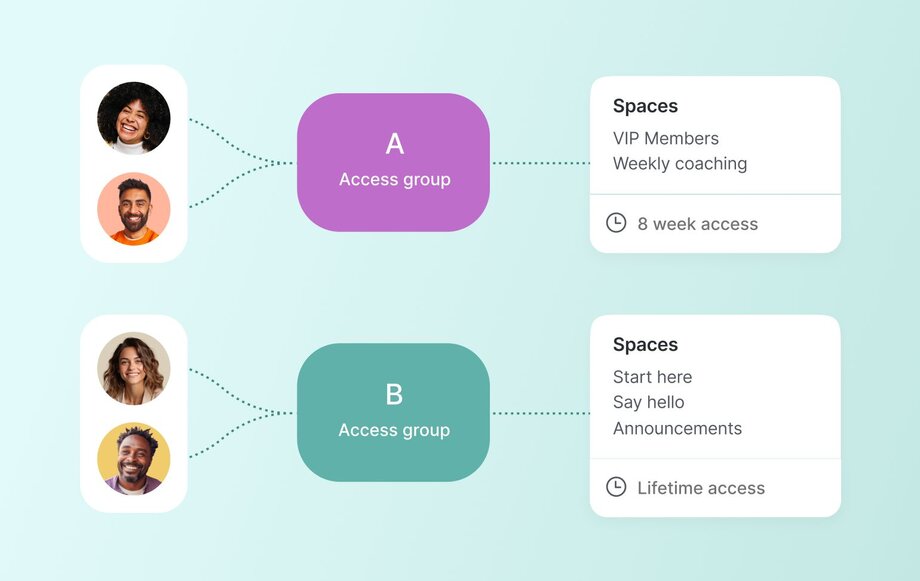
For example, Circle lets you customize your community experience to include open spaces, private channels, pre-recorded courses, and rich media attachments (e.g., videos and podcasts). Our UI simplifies cohort creation, space gating, and building out your customized offer funnel in the best way that works for your business.
6. Event management
You don’t need to be a pro planner or have the biggest budget to host a successful community event. Simply look for member management software with critical event planning tools like:
- Registration and ticketing
- Calendar integration, and
- Attendance tracking

These features help you organize all your event operations in one place so you can manage everything without breaking a sweat. They also aid smooth communication and collaboration, ensuring all team members and participants know what to do and what to expect throughout.
Another great event management feature to look out for is repurposing events into posts, transcripts, emails, and more.
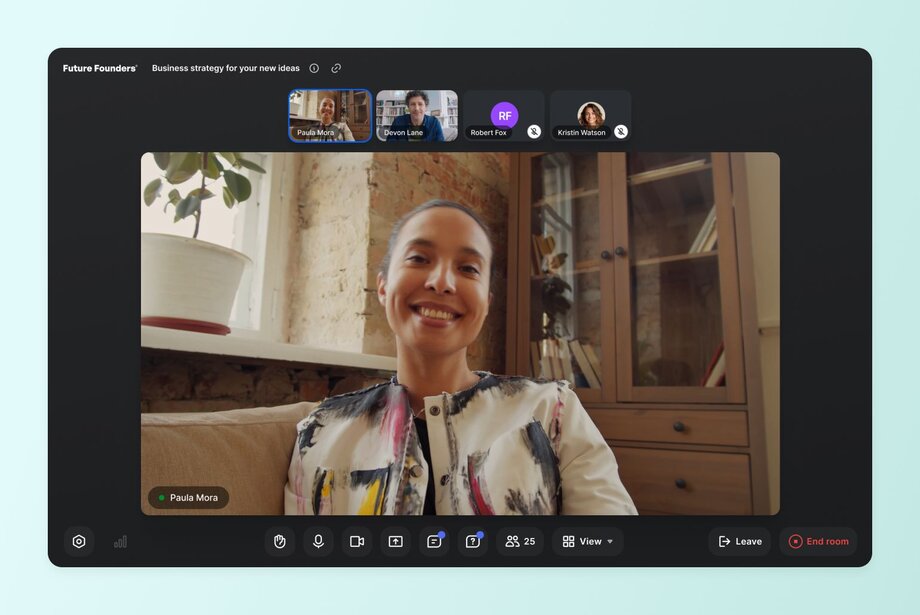
The best membership management tools let you record live events, auto generate transcripts for accessibility and searchability, and create summaries or follow-up tasks for attendees. This way, you can stretch your event ROI to the max.
7. Reporting and analytics
Why monitor community performance manually when you can just pick a membership management tool to do it for you?
Choose an app that automates reporting and shows insights in real time, so you can see the health of your audience base and quickly make informed decisions about marketing, monetization, retention, growth, and more.
Consider how detailed the software’s reports are and confirm that it provides the key data you need at a glance, like:
- Membership engagement metrics: Active members (great for member-led programs), inactive members, daily active members (DAU), and members who haven’t accepted your community invite.
📆 If events are a big part of your business strategy, you may also want to see event metrics to build a data-driven event strategy.

- Financial reports: Number of transactions, revenue breakdowns, conversion rate, and customer lifetime value (CLV).

- Growth analytics: New members, posts, likes, and comments.
Also, check if you can generate custom reports like leaderboards and active times using filters (e.g., date, member activity, engagement level, or location).
8. Integration capabilities
As a community builder or manager, your audience’s needs will change with time, trends, and growth. And no membership management software solution will have every feature or add-on you need at each stage. Opt for a tool with plenty of integrations and flexibility to eliminate multiple data entries across tools and reflect all updates made in connected apps.
Some Circle integration features you can explore include:
- API availability: Circle offers multiple APIs to help you build automations and migrate data easily.
- Third-party software compatibility: You can connect Circle to many apps via Zapier or code snippets.
- Website integration options: Circle’s headless functionality (plus APIs and 3rd-party tool compatibility) lets you natively add its community features to your website and app.
How to choose the right software
A quick Google search for top membership management software is easy. But picking a tool that matches your needs without frustrating community members (or you)? Not so much.
You need to do tons of research and consider factors like:
- Budgeting: Can you afford just one tool or a stack of tools? And if you go for the latter, is it really more efficient or simply convenient in the short term?
- Scalability: Will the membership management software grow with you or is it limited to a certain number of users?
- Ease of use: How tech-savvy do you need to be to use the app?
- Support: Does the tool offer guided onboarding, education, help docs, or a community forum?
- Migration: How easy is it to switch from another software?
Cost considerations
Different tools bill differently. Choose one that fits your budget by considering their pricing models: per member, flat fee, feature tiers, etc.
For example, Slack charges from $8.75 per user monthly while Circle offers a flat fee, starting at $89 a month. If you have 10 members or more, chances are a Circle community (including all of the extra features it has other than just a chat interface) would be a better deal.
The next thing to factor in is hidden costs like add-ons, integrations, developer time, and more. Then, estimate the tool’s potential ROI using indicators like time saved, your own revenue consistency, and the amount of support you’ll need from the tool’s support team.
Let’s take a look at some scenarios:
- Startup or solopreneur: Because of tight budgets, consider opting for a tool with a flat monthly fee (like Circle), which simplifies budgeting and helps avoid surprise charges (like spiralling added costs per member, which punish you for growing).
- Growing business with scaling costs: As membership numbers grow, the monthly cost increases, so the business must constantly monitor membership counts to ensure the tool remains cost-effective. If the growth trajectory is fast, this could lead to unexpectedly high costs. However, if the tool offers a scalable feature set, it might be worth the investment as the business expands.
- Enterprise or high-volume community: Larger businesses should prioritize tools with flexible pricing and scalable features, offering robust reporting, analytics, and integrations. Despite higher upfront costs, the ROI is clear with time-saving automation, enhanced security, and seamless scalability for rapid growth.
“I am so happy I have migrated here from the Skool platform. Circle has just so much more to offer. I am so pleased with the massive potential that having multiple spaces brings.”
—William Johnson, Founder of EcoCouture Alliance
Implementation best practices
Choosing a membership management tool is only the first half of streamlining your community operations. The other half is setting it up.
Need a starter guide? Here’s one:
- Plan your migration: This step includes importing your member and email database, switching payment systems, among other systems. Skip it if you are just starting your community.
- Train your team or VA (if applicable): If you don’t run a solo community management show, you’ll need to invest in teaching your team to use the new software. Schedule training sessions where they get to watch demo videos, take guided tours, or learn directly from the app’s support agents.
- Avoid common setup pitfalls: When setting up a membership site, issues like unstructured tiers and unclear permissions can easily slow you down. Prevent these issues by thoroughly assessing your management tool before go-live.
- Give yourself a 30-day setup runway: Don’t use your members as lab rats—take your time to set up critical spaces, subscription tiers, payments, and more before migrating them to the tool.
Find a membership management software that supports your bottom line
Determining your community’s ideal membership site software takes dedication and attention to detail. But, it is so worth it because you’ll save time on manual tasks and spend more time building valuable connections.
Remember to consider key features, compare platforms, and try demos. Here's Circle's 14-day free trial to get you started!